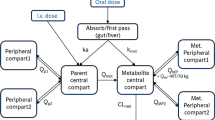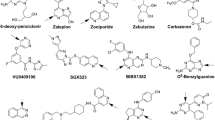Abstract
Objectives
To evaluate zolpidem as a mechanism-based inactivator of human CYP3A in vitro, and to assess its metabolic interaction potential with CYP3A drugs (in vitro-in vivo extrapolation; IV-IVE).
Methods
A co- vs. pre-incubation strategy was used to quantify time-dependent inhibition of human liver microsomal (HLM) and recombinant CYP3A4 (rCYP3A4) by zolpidem. Experiments involving a 10-fold dilution step were employed to determine the kinetic constants of inactivation (K I and k inact) and to assess the in vitro mechanism-based inactivation (MBI) criteria. Inactivation data were entered into the Simcyp population-based ADME simulator to predict the increase in the area under the plasma concentration-time curve (AUC) for orally administered midazolam.
Results
Consistent with MBI, the inhibitory potency of zolpidem toward CYP3A was increased following pre-incubation. In HLMs, the concentration required for half maximal inactivation (K I) was 122 µM and the maximal rate of inactivation (k inact) was 0.094 min−1. In comparison, K I and k inact values with rCYP3A4 were 50 µM and 0.229 min−1, respectively. Zolpidem fulfilled all other in vitro MBI criteria, including irreversible inhibition. The mean oral AUC for midazolam in healthy volunteers was predicted to increase 1.1- to 1.7-fold due to the inhibition of metabolic clearance by zolpidem. Elderly subjects were more sensitive to the interaction, with mean increases in midazolam AUC of 1.2- and 2.2-fold for HLM IV-IVE and rCYP3A4 IV-IVE, respectively.
Conclusions
Zolpidem is a relatively weak mechanism-based inactivator of human CYP3A in vitro. Zolpidem is unlikely to act as a significant perpetrator of metabolic interactions involving CYP3A.



Similar content being viewed by others
References
Polasek TM, Miners JO (2007) In vitro approaches to investigate mechanism-based inactivation of CYP enzymes. Expert Opin Drug Metab Toxicol 3:321–329
Mayhew BS, Jones DR, Hall SD (2000) An in vitro model for predicting in vivo inhibition of cytochrome P450 3A4 by metabolic intermediate complex formation. Drug Metab Dispos 28:1031–1037
Ito K, Ogihara K, Kanamitsu S, Itoh T (2003) Prediction of the in vivo interaction between midazolam and macrolides based on in vitro studies using human liver microsomes. Drug Metab Dispos 31:945–954
Jamei M, Dickinson GL, Rostami-Hodjegan A (2009) A framework for assessing inter-individual variability in pharmacokinetics using virtual human populations and integrated general knowledge of physical chemistry, biology, anatomy, physiology and genetics: a tale of ‘bottom-up’ vs ‘top-down’ recognition of covariates. Drug Metab Pharmacokinet 24:53–75
Kanamitsu S, Ito K, Green CE, Tyson CA, Shimada N, Sugiyama Y (2000) Prediction of in vivo interaction between triazolam and erythromycin based on in vitro studies using human liver microsomes and recombinant human CYP3A4. Pharm Res 17:419–426
Obach RS, Walsky RL, Venkatakrishnan K (2007) Mechanism-based inactivation of human cytochrome P450 enzymes and the prediction of drug-drug interactions. Drug Metab Dispos 35:246–255
Zhang X, Jones DR, Hall SD (2009) Prediction of the effect of erythromycin, diltiazem, and their metabolites, alone and in combination, on CYP3A4 inhibition. Drug Metab Dispos 37:150–160
Galetin A, Burt H, Gibbons L, Houston JB (2006) Prediction of time-dependent CYP3A4 drug-drug interactions: impact of enzyme degradation, parallel elimination pathways, and intestinal inhibition. Drug Metab Dispos 34:166–175
Fahmi OA, Hurst S, Plowchalk D, Cook J, Guo F, Youdim K, Dickins M, Phipps A, Darekar A, Hyland R, Obach RS (2009) Comparison of different algorithms for predicting clinical drug-drug interactions, based on the use of CYP3A4 in vitro data; predictions of compounds as precipitants of interaction. Drug Metab Dispos 37:1658–1666
Fahmi OA, Maurer TS, Kish M, Cardenas E, Boldt S, Nettleton D (2008) A combined model for predicting CYP3A4 clinical net drug-drug interaction based on CYP3A4 inhibition, inactivation, and induction determined in vitro. Drug Metab Dispos 36:1698–1708
Einolf HJ (2007) Comparison of different approaches to predict metabolic drug-drug interactions. Xenobiotica 37:1257–1294
Grime KH, Bird J, Ferguson D, Riley RJ (2009) Mechanism-based inhibition of cytochrome P450 enzymes: an evaluation of early decision making in vitro approaches and drug-drug interaction prediction methods. Eur J Pharm Sci 36:175–191
Grimm SW, Einolf HJ, Hall SD, He K, Lim H-K, Ling K-H, Lu C, Nomeir AA, Seibert E, Skordos KW, Tonn GR, Van Horn R, Wang RW, Wong YN, Yang TJ, Obach RS (2009) The conduct of in vitro studies to address time-dependent inhibition of drug metabolizing enzymes: a perspective of the pharmaceutical research and manufacturers of America (PhRMA). Drug Metab Dispos 37:1355–1370
Riley RJ, Grime K, Weaver R (2007) Time-dependent CYP inhibition. Expert Opin Drug Metab Toxicol 3:51–66
Venkatakrishnan K, Obach RS (2007) Drug-drug interactions via mechanism-based cytochrome P450 inactivation: points to consider for risk assessment from in vitro data and clinical pharmacologic evaluation. Current Drug Metab 8:449–462
Venkatakrishnan K, Obach RS, Rostami-Hodjegan A (2007) Mechanism-based inactivation of human cytochrome P450 enzymes: strategies for diagnosis and drug-drug interaction risk assessment. Xenobiotica 37:1225–1256
Pichard L, Gillet G, Bonfils C, Domergue J, Thénot J-P, Maurel P (1995) Oxidative metabolism of zolpidem by human liver cytochrome P450s. Drug Metab Dispos 23:1253–1262
von Moltke LL, Greenblatt DJ, Granda BW, Duan SX, Grassi JM, Venkatakrishnan K, Harmatz JS, Shader RI (1999) Zolpidem metabolism in vitro: responsible cytochromes, chemical inhibitors, and in vivo correlations. Br J Clin Pharmacol 48:89–97
Greenblatt DJ, von Moltke LL, Harmatz JS, Mertzanis P, Graf JA, Durol AL, Counihan M, Roth-Schechter BF, Shader RI (1998) Kinetic and dynamic interaction study of zolpidem with ketoconazole, itraconazole, and fluconazole. Clin Pharmacol Ther 64:661–671
Villikka K, Kivistö KT, Luurila H, Neuvonen PJ (1997) Rifampin reduces plasma concentrations and effects of zolpidem. Clin Pharmacol Ther 62:629–634
Saari TI, Laine K, Leino K, Valtonen M, Neuvonen PJ, Olkkola KT (2007) Effect of voriconazole on the pharmacokinetics and pharmacodynamics of zolpidem in healthy subjects. Br J Clin Pharmacol 63:116–120
Farkas D, Volak LP, Harmatz JS, von Moltke LL, Court MH, Greenblatt DJ (2009) Short-term clarithromycin administration impairs clearance and enhances pharmacodynamic effects of trazodone but not of zolpidem. Clin Pharmacol Ther 85:644–650
Hesse LM, von Moltke LL, Greenblatt DJ (2003) Clinically important drug interactions with zopiclone, zolpidem and zaleplon. CNS Drugs 17:513–532
Allard S, Sainati SM, Roth-Schechter BF, MacIntyre J (1998) Minimal interaction between fluoxetine and multiple-dose zolpidem in healthy women. Drug Metab Dispos 26:617–622
Allard S, Sainati SM, Roth-Schechter BF (1999) Coadministration of short-term zolpidem with sertraline in healthy women. J Clin Pharmacol 39:184–191
Cysneiros RM, Farkas D, Harmatz JS, von Moltke LL, Greenblatt DJ (2007) Pharmacokinetic and pharmacodynamic interactions between zolpidem and caffeine. Clin Pharmacol Ther 82:54–62
Miners JO, Birkett DJ (1996) The use of caffeine as a metabolic probe for human drug metabolizing enzymes. Gen Pharmacol 27:245–249
von Moltke LL, Weemhoff JL, Perloff MD, Hesse LM, Harmatz JS, Roth-Schechter BF, Greenblatt DJ (2002) Effect of zolpidem on human cytochrome P450 activity, and on transport mediated by P-glycoprotein. Biopharm Drug Dispos 23:361–367
Bomsien S, Skopp G (2007) An in vitro approach to potential methadone metabolic-inhibition interactions. Eur J Clin Pharmacol 63:821–827
Polasek TM, Miners JO (2006) Quantitative prediction of macrolide drug-drug interaction potential from in vitro studies using testosterone as the human cytochrome P4503A probe substrate. Eur J Clin Pharmacol 62:203–208
Periti P, Mazzei T, Mini E, Novelli A (1992) Pharmacokinetic drug interactions of macrolides [erratum appears in Clin Pharmacokinet 1993 Jan;24(1):70]. Clin Pharmacokinet 23:106–131
Ghanbari K, Rowland-Yeo K, Bloomer JC, Clarke SE, Lennard MS, Tucker GT, Rostami-Hodjegan A (2006) A critical evaluation of the experimental design of studies of mechanism-based enzyme inhibition, with implications for in vitro-in vivo extrapolation. Current Drug Metab 7:315–334
Yang J, Jamei M, Rowland-Yeo K, Tucker GT, Rostami-Hodjegan A (2007) Theoretical assessment of a new experimental protocol for determining kinetc values describing mechanism (time)-based enzyme inhibition. Eur J Pharm Sci 31:232–241
Bowalgaha K, Elliot DJ, Mackenzie PI, Knights KM, Swedmark S, Miners JO (2005) S-Naproxen and desmethylnaproxen glucuronidation by human liver microsomes and recombinant human UDP-glucuronosyltransferases (UGT): role of UGT2B7 in the elimination of naproxen. Br J Clin Pharmacol 60:423–433
Polasek TM, Elliot DJ, Lewis BC, Miners JO (2004) Mechanism-based inactivation of human cytochrome P4502C8 by drugs in vitro. J Pharmacol Exp Ther 311:996–1007
Polasek TM, Elliot DJ, Somogyi AA, Gillam EM, Lewis BC, Miners JO (2006) An evaluation of potential mechanism-based inactivation of human drug metabolizing cytochromes P450 by monoamine oxidase inhibitors, including isoniazid. Br J Clin Pharmacol 61:570–584
Maurer TS, Tabrizi-Fard MA, Fung H-L (2000) Impact of mechanism-based enzyme inactivation on inhibitory potency: implications for rational drug discovery. J Pharm Sci 89:1404–1414
Berry LM, Zhao Z (2008) An examination of IC50 and IC50-shift experiments in assessing time-dependent inhibition of CYP3A4, CYP2D6 and CYP2C9 in human liver microsomes. Drug Metab Lett 2:51–59
Jamei M, Marciniak S, Feng K, Barnett A, Tucker G, Rostami-Hodjegan A (2009) The Simcyp population-based ADME simulator. Expert Opin Drug Metab Toxicol 5:1–13
McConn DJ 2nd, Lin YS, Allen K, Kunze KL, Thummel KE (2004) Differences in the inhibition of cytochromes P450 3A4 and 3A5 by metabolite-inhibitor complex-forming drugs. Drug Metab Dispos 32:1083–1091
Wang Y, Jones DR, Hall SD (2005) Differential mechanism-based inhibition of CYP3A4 and CYP3A5 by verapamil. Drug Metab Dispos 33:664–671
Bjornsson TD, Callaghan JT, Einolf HJ, Fischer V, Gan LS, Grimm SW, Kao J, King SP, Miwa G, Ni L, Kumar GN, McLeod J, Obach RS, Roberts S, Roe A, Shah A, Snikeris F, Sullivan JT, Tweedie D, Vega JM, Walsh J, Wrighton SA (2003) The conduct of in vitro and in vivo drug-drug interaction studies: a Pharmaceutical Research and Manufacturers of America (PhRMA) perspective. Drug Metab Dispos 31:815–832
Obach RS, Walsky RL, Venkatakrishnan K, Gaman EA, Houston JB, Tremaine LM (2006) The utility of in vitro cytochrome P450 inhibition data in the prediction of drug-drug interactions. J Pharmacol Exp Ther 316:336–348
von Moltke LL, Durol AL, Duan SX, Greenblatt DJ (2000) Potent mechanism-based inhibition of human CYP3A in vitro by amprenavir and ritonavir: comparison with ketoconazole. Eur J Clin Pharmacol 56:259–261
Salvà P, Costa J (1995) Clinical pharmacokinetics and pharmacodynamics of zolpidem: therapeutic implications. Clin Pharmacokinet 29:142–153
Albin H, Vincon G, Vincon J, Hermann P, Thiercelin JF (1988) Study of the pharmacokinetics of zolpidem in healthy volunteers after repeated administration: effects on antipyrine clearance. In: Sauvanet JP, Langer SZ, Morselli PL (eds) Imidazopyridines in sleep disorders: a novel experimental and therapeutic approach. Raven Press, New York, pp 369–370
Kharasch ED, Hoffer C, Whittington D, Sheffels P (2004) Role of hepatic and intestinal cytochrome P450 3A and 2B6 in the metabolism, disposition, and miotic effects of methadone. Clin Pharmacol Ther 76:250–269
Johnson WW (2008) Cytochrome P450 inactivation by pharmaceuticals and phytochemicals: therapeutic relevance. Drug Metab Rev 40:101–147
Polasek TM, Miners JO (2008) Time-dependent inhibition of human drug metabolizing cytochromes P450 by tricyclic antidepressants. Br J Clin Pharmacol 65:87–97
Ma B, Prueksaritanont T, Lin JH (2000) Drug interactions with calcium channel blockers: possible involvement of metabolite-intermediate complexation with CYP3A. Drug Metab Dispos 28:125–130
Franklin MR (1991) Cytochrome P450 metabolic intermediate complexes from macrolide antibiotics and related compounds. Methods Enzymol 206:559–573
Acknowledgements
This work was supported by grants from the Flinders Medical Centre Foundation and the National Health and Medical Research Council of Australia. We thank Benjamin C. Lewis for the preparation of recombinant CYP3A4 and Kushari Bowalgaha for assisting in the preparation of human liver microsomes. The authors declare that experiments with human liver tissue were approved by the Flinders Medical Centre Ethics Review Committee under current Australian Law. Part of this work was presented at the 16th North American ISSX meeting, October 2009, Baltimore, MD, USA.
The authors have no competing interests to declare.
Author information
Authors and Affiliations
Corresponding author
Rights and permissions
About this article
Cite this article
Polasek, T.M., Sadagopal, J.S., Elliot, D.J. et al. In vitro-in vivo extrapolation of zolpidem as a perpetrator of metabolic interactions involving CYP3A. Eur J Clin Pharmacol 66, 275–283 (2010). https://doi.org/10.1007/s00228-009-0760-2
Received:
Accepted:
Published:
Issue Date:
DOI: https://doi.org/10.1007/s00228-009-0760-2




